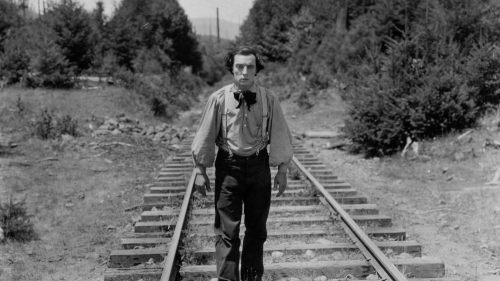The First Best Picture
Every year, film fans work themselves into a lather over the idea of a mainstream, safe, populist piece of entertainment winning Best Picture at the Academy Awards. We wring our hands and act as if awarding the statue to anything less than a game-changing work of art is somehow sullying the sacred institution of Oscar. Forrest Gump. Titanic. Shakespeare In Love. Movies that make a bundle, that have high production value, and that make your aunt call herself a movie lover. But a look back at Wings, the very first Best Picture*, reminds us that big, flashy, middle of the road movies winning Best Picture IS the tradition.
1927’s Wings is mainstream as heck, a corny story of love and friendship set against the horrors of the First World War. But it’s also a technical marvel, an innovative thrill ride that can still impress viewers 88 years after its release. It remains impressive because of a frankly astonishing level of authenticity, leaving any contemporary viewing fraught with reactions of, “Oh...oh, they’re really doing that...that’s actually happening.” None of the scenes in which the film’s characters take to the skies in fighter planes are a feat of visual effects technicians, at least as we understand the role today. Model work can be an exquisite art form in itself, and CGI might rapidly be closing the uncanny valley, but there still exists in viewers a visceral, almost primordial reaction to witnessing actual peril, and Wings is kind of packed with it. Though you know what you’re watching is scripted and planned, there’s a level of reality to the aerial battle scenes that puts a knot in your stomach. There are no composite shots, no back projection signaling you to suspend your disbelief. When a character in the film is engaged in a dogfight at 10,000 feet, the scene was accomplished by mounting a camera aimed at the cockpit, and placing an actor in the cockpit. The actor then flew to the desired altitude, started the camera himself, and ran through the scripted action - which often included being hit by gunfire and spurting blood - all while actually flying the plane. Director William Wellman was in real life a fighter pilot in World War I, and his eye for detail (as well as the head-spinning logistics involved in filming actors playing out whole scenes a mile above the earth) pushes Wings into the realm of the incredible. The completed dogfight scenes in Wings are nothing less than revolutionary, creating a visual language spoken in films for the rest of the century, perhaps echoing hardest for this generation in 1977’s Star Wars.
The innovation in Wings isn’t relegated to the skies. Wellman and his crew were forced into an 18-day delay in filming while waiting for the clouds to form just the right backdrop for the dogfights. He used the downtime to extensively rehearse the climactic Battle of Saint-Mihiel, a sequence which employed hundreds of extras on the ground as well as the air. The battle takes a turn toward vérité, thanks to Wellman (who was a survivor of the real event) handing out 20 cameras to men on the battlefield, with loose instructions to film whatever action they saw happening.
Wellman’s wartime experience pays dividends in other ways. The 30-year-old combat veteran-turned-director never misses a chance to show us the human toll of war, and it’s those moments which might most surprise a contemporary audience. Gary Cooper’s walk-on as a doomed pilot is a surprisingly effective bit of business, and David’s farewell to his parents, a stuffy, wealthy old couple sending their boy off to war, is a restrained yet heartfelt moment that had me legitimately choked up. You won’t find many examples of the stylized, overwrought “playacting” associated with silent films. Instead, Wellman’s cast - Clara Bow (Mary), Charles “Buddy” Rogers (Jack) and Richard Arlen (David) bring a level of pathos and teary-eyed gravitas to Wellman’s film, with human, emotional scenes that still work.
There’s also a real unbridled freedom to the emotions in Wings, and 88 years later they catch one off guard. In the film’s finale, a man strokes the hair of his dying best friend, kissing him on the face with tearful abandon. Watching it today, the effect is downright startling, and the fact is that once the Hays Code kicked in, you’d be hard pressed to find physical fraternal affection like this onscreen again. It raises a curious question: as male behavior became more rigidly codified in the '30s and '40s, and a century of men looked to movie heroes to define themselves, how much real world male behavior was in fact shaped (and incidentally suppressed) by Hollywood censorship?
Sitting as it does just out of reach of the Hays Code, a more Libertine aesthetic tints the picture, especially in a sequence in which the pilots hit Paris on leave. A compelling juxtaposition takes shape: the film casually shows men’s bare asses and Bow’s bare breasts, but is similarly unblinking as soldiers spurt blood from their mouths before they die, staring wide-eyed up at the sky. That level of candor and gravity must have been quite jarring in 1927, especially presented as it was in select theaters in “Magnascope,” a process which employed a greatly enlarged screen and crude sound effects - plane engines, explosions, gunfire (in different pitches to distinguish between US and German forces). IMAX before IMAX; Sensurround sound before talkies. On every front, Wings was an all-out spectacle, and its DNA winds its way through many, many Best Picture winners in the decades that followed. Pitching a fit that mainstream blockbusters are taking home the statue today seems disingenuous at best.
Wings was rather stunningly restored in 2012, and is available to watch on Amazon Prime.
*Technically, at the first Academy Awards, Wings won "Outstanding Picture" and F.W. Murnau’s Sunrise won “Unique and Artistic Production.” Both were considered the evening's top honors, but the latter category was dropped the next year, and “Outstanding Picture” went through a series of name changes, landing on “Best Picture” in 1962.



